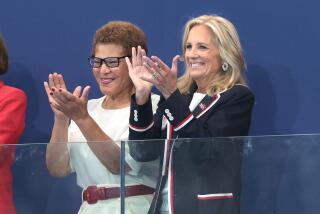L.A. Seeking to Put the Brakes on City Gridlock
Los Angeles shed its image as a slow, peaceful suburban village long ago--about the time the smog sieges of the 1950s first sent school kids home gasping for air.
Still, it may shock some old-time residents that City Hall is looking at an anti-gridlock law for Los Angeles streets like those in two of the English-speaking world’s oldest and most-crowded cities, New York and London.
The sheer size of the street system makes true gridlock rare in Los Angeles, even downtown. But traffic jams that resemble it have become more common.
Such jam-ups usually begin when impatient drivers nose into an intersection and get stuck there on the red light. It’s the bane of traffic officials everywhere. When those interlopers squat in the intersection, traffic can’t move in any direction and gridlock is threatened.
Anti-gridlock laws try to solve the problem by educating drivers--and with high fines on violators who cross into an intersection without seeing a clear path out the other side.
London traffic officials outline key intersections with bright white stripes and advise motorists to stay out of “The Box.” In Manhattan, special signs that announce “Gridlock Busters” in big letters warn motorists that a violation can cost them money and count as a moving violation against their driver’s license.
In Los Angeles the concept grew out of the police and the Community Redevelopment Agency, the city department whose plans for rapid high-rise growth downtown are jeopardized by increasing congestion. Discussions began last year.
The idea gained momentum Friday when City Councilman Mike Woo, as part of a series of proposed new traffic measures, asked the city’s legal staff to see if stricter law enforcement at intersections is legal.
Woo was not prepared to say how such a law should be worded. But he said it does appear to be needed, because police can ticket now only if there is a sign posted that warns drivers not to block the intersection.
“There is no greater contributing factor to gridlock in this city than people who do not obey the red light,” said Councilman Zev Yaroslavsky, who joined Woo in unveiling the traffic measures. “Most of us do not respect the intersectional boundaries.”
Woo’s package of measures, which he is sponsoring as chairman of the council’s Transportation and Traffic Committee, may be more notable for its list of initial supporters than for any concrete provisions.
Woo was joined at a morning press conference both by Yaroslavsky and Councilman Marvin Braude, who are thought of as the strongest City Hall critics of the rapid development that traffic experts say has worsened the city’s congestion. They also were the authors of Proposition U, the measure passed by voters in November that limits high-rise building in some areas of the city.
But the trio, who are often aligned, were joined Friday by council President Pat Russell, a frequent rival who led the unsuccessful fight to weaken the impact of Proposition U before it ran up a big victory margin on election day.
Woo’s package essentially calls for a series of studies on how to speed up traffic signal computerization, promote ride-sharing by city employees, expand the use of one-way streets, make better use of rapid transit money and introduce an innovative traffic control system along the Ventura Freeway. He also wants the city to look into allowing its employees to work at satellite computer offices rather than driving downtown to City Hall, an approach sometimes called “telecommuting.”
Woo said he decided to look at these steps after a number of brainstorming sessions with local transportation experts. He conceded that most of the ideas are not new, but Woo said that “now is the time for the City Council to provide the leadership necessary.”
Also Friday, the City Council gave its final approval to a law originated by Russell that may lead to developers in congested areas paying a fee for the new traffic that they generate.
More to Read
Sign up for Essential California
The most important California stories and recommendations in your inbox every morning.
You may occasionally receive promotional content from the Los Angeles Times.










